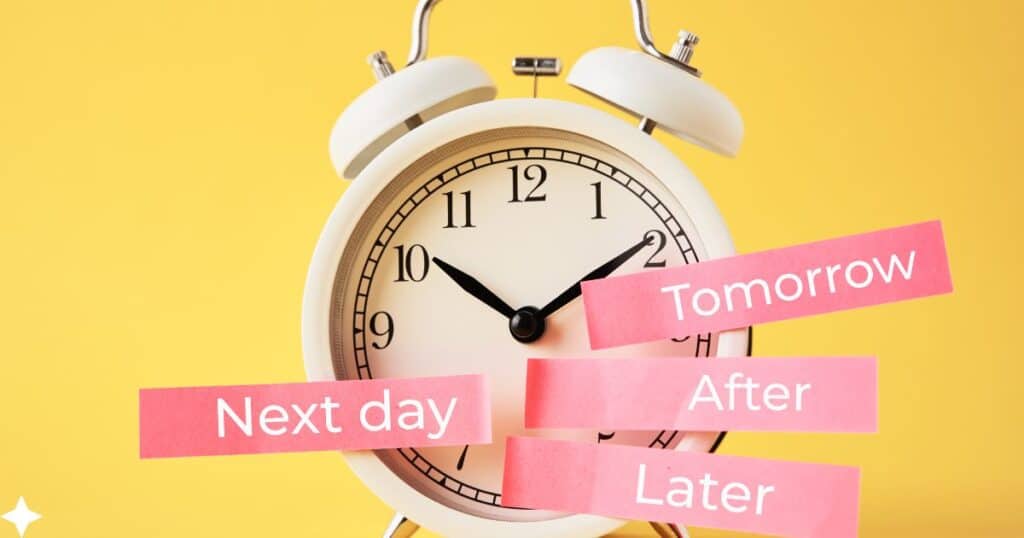
10 Simple Ways to Overcome Procrastination
Procrastination. We all do it. You know the feeling—you’ve got something important to do, but somehow, you just… don’t.
Instead, you find yourself scrolling through your phone. Rearranging your desk. Doing anything that isn’t the crucial task at hand.
But why? Why do we do this?
Procrastination isn’t laziness. It’s not about being unproductive. I procrastinate, even though I’m always busy.
Procrastination is about fear. Fear of failure. Fear of not being perfect. Fear of the unknown.
But here’s the thing: procrastination steals your time. It stops you from being your best. It’s like a wall between you and what you want to achieve.
Do you want to tear that wall down?
It doesn’t have to be complicated. You don’t need a miracle cure. Just a few simple changes. Things you can start doing today to stop procrastination in its tracks.
What Is Procrastination?
Procrastination is that little voice in your head that says, “I’ll do it later.” It’s the habit of putting off things that matter, usually for things that don’t.
Procrastination isn’t just a time-waster. It’s a thief. It steals your time, your energy, your potential. It’s about avoiding what feels uncomfortable. Sometimes, it’s fear disguised as delay. And the longer you wait, the bigger the task seems—until it feels impossible to start.
The Mañana Habit, Its Bad Effects, & 5 Ways to Fix It

Why Address Procrastination?
Because procrastination holds you back.
Every time you procrastinate, you’re giving up a little bit of your potential.
You miss out on opportunities. You create unnecessary stress. You end up doing things last-minute, which usually means they’re not your best work. Procrastination erodes your confidence, too. It makes you doubt yourself and your abilities.
How to Beat Procrastination
You can beat procrastination. You can change how you see the tasks that lead you to procrastinate. You can change how you behave in situations that trigger it. You can change how you live.
Open the door to more time, peace of mind, and success. Show up for yourself and your goals.
1. Set Clear Goals
Ever noticed how easy it is to put something off when you’re not really sure what you need to do?
That’s where clear goals come in.
Break tasks down into specific, manageable steps. Create a roadmap. Each task becomes doable. You’ll know exactly where to start.
Instead of telling yourself, “I need to finish this project,” say, “Today, I’ll outline the main points.” Tomorrow, tackle the next step.
You don’t have to finish everything at once.
For example, I might leave this article unfinished today. What’s important is that I started writing it. After 30 minutes, I’ll move on to other important tasks.
By the time I return to this article, I’ll have richer ideas. I’ll know what to write in my LinkedIn post, too.
Remember, you don’t have to finish every task. Some tasks, like writing an article, can be done in 30 minutes. But to write a useful and quality article requires thinking and unthinking.
What’s important is that you’re not afraid to start. Once you start, momentum builds.
Cleaning the house? Don’t try to do it all in one go. Start with the kitchen today, the living room tomorrow. Small wins lead to big results.
2. Use the Two-Minute Rule
If something important takes two minutes or less, do it now. Don’t overthink it, don’t put it off. Just get it done.
If calling a client takes 30 seconds, do it now.
If sending an email that will close the deal takes two minutes, do it now.
The Two-Minute Rule helps you stop the little things from piling up. You know those small tasks that seem harmless but eventually snowball into stress?
The Two-Minute Rule wipes them out before they even have a chance. It’s a quick win and keeps your to-do list manageable.
Next time you finish your coffee, don’t leave the cup on the table—take it to the sink right away.
Got an email you’ve been meaning to send? Knock it out in two minutes. These tiny actions add up, and before you know it, you’ve cleared a bunch of tasks without breaking a sweat.
3. First Things First
Not all tasks are created equal, right? Some are more important than others. Figure out what matters and tackle that first. Everything else can wait.
When you start your day, think about what’s going to make the biggest impact. What needs to be done today to make it a good day? Focus on those top priorities before getting caught up in less important tasks.
Say you’re preparing for a big meeting. That’s your priority.
Answering non-urgent emails? That can wait until after you’ve handled the important stuff. By focusing on first things first, you’re in control of your day, and you end it feeling accomplished.
Do First Things First: Do What Matters Most
4. Create Your Game Plan
Schedules are your best friend when it comes to beating procrastination. Think of it as your game plan for the day.
When you’ve got a schedule, you’re less likely to drift off into distractions. You know exactly what you should be doing and when.
Here’s the trick: don’t just create any schedule—make one that works for you.
Block out time for the big tasks first, and don’t forget to include breaks. Give your day structure so you can flow from one task to the next without getting stuck.
Imagine starting your day knowing you’ve got 9 AM to 10 AM set aside for that report you’ve been dreading. When 10 AM hits, move on to the next thing.
No need to overthink it. Just follow the plan, and watch how much easier it is to keep moving.
5. Eliminate Distractions
Distractions are everywhere. Your phone, those browser tabs, that pile of papers on your desk. It’s no wonder we procrastinate when our attention is being pulled in a million directions.
The solution? Clear the clutter, both digital and physical.
Identify your biggest distractions. Is it your phone? Put it on silent or leave it in another room when you’re working. Too many open tabs? Close the ones you don’t need.
The goal is to create a workspace that helps you focus, not one that tempts you to procrastinate.
Picture this: you sit down to work, and your desk is clear. Your phone is out of sight, and only the tab you need is open. Suddenly, it’s just you and the task at hand.
Feels different, right? That’s the power of eliminating distractions.
6. Use Positive Reinforcement
Give yourself a little something to look forward to after you’ve completed a task. It’s like a pat on the back that keeps you motivated to keep going.
Think of it as a simple exchange: “If I finish this task, I get to enjoy a break,” or “Once I’m done with this project, I’ll treat myself to something nice.”
It doesn’t have to be big—sometimes, a cup of coffee or a short walk is enough to keep you going.
Imagine telling yourself, “If I get through these emails, I’m going to take 10 minutes to relax.”
You’ll be surprised how much more motivated you feel when there’s a little reward waiting for you at the end.
Turn work into something to look forward to, not something to dread.
7. Practice Mindfulness
Mindfulness is a powerful tool against procrastination.
Be present in the moment and fully engaged with what you’re doing right now.
When you’re mindful, you’re less likely to get caught up in worries about the future or regrets about the past—two big triggers for procrastination.
How do you practice mindfulness?
Start with simple breathing exercises. When you feel your mind wandering or that urge to procrastinate creeping in, take a few deep breaths. Focus on the here and now.
Reset the fresh button for your brain.
Picture this: you’re in the middle of a task, and suddenly your mind starts drifting. Instead of letting it pull you away, you take a deep breath and refocus.
Mindfulness beats procrastination.
8. Seek Accountability
When someone else knows what you’re supposed to be doing, you’re more likely to get it done. Having a support system helps you stay on track.
This could be as simple as telling a friend or colleague about your goals and asking them to check in on you.
Or you could join a group where everyone shares their progress and encourages each other. Knowing that someone else is rooting for you (or might ask how it’s going) can be a powerful motivator.
Imagine you’ve told a friend that you’re going to finish that report by the end of the day. When they check in with you later, you want to be able to say, “Yep, it’s done!”
Accountability adds that extra push to keep you moving forward.
The Accountability Mindset: Cultivating Ownership and Responsibility
9. Visualize Success
Visualization isn’t just for athletes—it’s for anyone who wants to achieve their goals. When you visualize success, you’re mentally rehearsing what it feels like to complete a task.
Think about how good it will feel to cross that task off your list. Picture yourself finishing the project, submitting it, and feeling a sense of accomplishment. The more vividly you imagine it, the more real it becomes—and the more motivated you’ll be to make it happen.
Of course, visualization itself won’t finish the task. Don’t visualize for an hour what can be done in two minutes. Visualize in seconds what you need to do in a day.
Next time you’re tempted to procrastinate, close your eyes for a moment. Picture the result. See yourself succeeding, and let that image pull you toward action.
It’s a simple, yet powerful, way to turn procrastination into productivity.
10. Do the Hardest Task
I start with a small task to get things going. As I’ve said, I slice hard tasks into small pieces. I like doing 10 percent of the task to gauge how fast it can be done.
This article, for example, is now taking me two hours to write. I’ve written other pieces on procrastination, but this isn’t a hard task at all.
But sometimes, a single task is the hardest to do.
Our brains make us avoid hard tasks. That’s why we procrastinate.
By doing the hard task, we tell our brains not to worry. We can do it. We will do it no matter how difficult because it’s important.
I’ve been there many times. I’ve put off the hardest task because it feels too big, too complicated, or just too unpleasant.
But here’s the thing: when I tackle the hardest task, it puts me in control of my day. I do it not just because it’s important, but because it challenges me.
It also gives me a sense of accomplishment. That momentum carries me through the rest of my tasks.
So, look at your to-do list and pick the one thing you’re dreading most. Dive into it.
Final Thoughts
Procrastination isn’t some insurmountable enemy. It’s a habit—one that you can break with the right tools and mindset.
These ten simple steps aren’t magic, but they work. The more you practice them, the more natural they’ll become, and the less procrastination will control your life.
But don’t just read this and move on.
Take action.
Right now, pick one thing—just one—that you’ve been putting off. It could be as small as sending an email or as big as starting that project you’ve been avoiding. Whatever it is, do it today. You’ll feel the difference immediately.
That’s how you start beating procrastination—one step
Responses